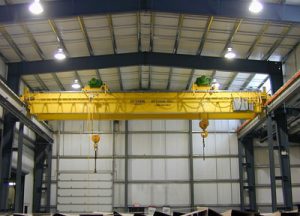 Your top 10 questions answered about overhead crane systems
Your top 10 questions answered about overhead crane systems
August 26, 2014 REDWIRE is news you can use from leading suppliers. Powered by FRASERS.
Posted by Engineered Lifting Systems & Equipment Inc.
With over 40 years of experience, Engineered Lifting Systems & Equipment Inc. provides standard & custom overhea... Read more
Subscribe
Free REDWIRE e-newsletter

Metropolitan skylines typically have one thing in common: an abundance of cranes constructing new residential and commercial developments.
While sometimes they may seem like obtrusive obstructions hanging over urbanites heads, these are not overhead cranes.
Unlike the tower cranes towering over soon-to-be condo zones inside construction sites, overhead cranes instead lift, raise and move objects horizontally.
The enhanced feature of overhead cranes (also known as bridge cranes) to load and unload sizeable materials is the accompanying bridge, with a wheeled trolley traversing parallel to the bridge.
Overhead cranes generally work behind the scenes in manufacturing industries, including the automotive, food and beverage, steel, pulp and paper and transportation and warehousing sectors. They also make outdoor cameo appearances near shipping loading docks by a port, or hang out on the other side of the tracks moving cargo in railway yards.
Sounds like the type of applications you do for your business? For those in the market looking to invest in an overhead crane (or just purely interested in boosting your crane knowledge) here are the most common considerations to ask yourself before going overhead crane shopping.
1. What style of overhead crane is suggested: Under Runner or Top Runner?
A Top Runner runs on crane rails, while an Under Runner runs on the bottom flange of a runway beam.
The benefit of an Under Runner is apparent when the crane system is supported directly by the building roof (which must first be verified) and runway columns are not necessary.
2. What crane capacity is required?
What will be lifted and how much does it weigh? Note, any below the hook devices should be added to the lifted load when determining capacities.
The maximum weight of your application should not exceed the lifting capacity of your crane.
3. What is the lift needed by the hoist?
The dimension from the floor or product to the maximum raised hook will need to be known. Do not forget to include any slings or below the hook devices that would influence this value.
4. What about the hoist weight?
Hoist weight may be a determining factor during the crane design phase. Consult with our engineering department to ensure hoist weight and values are not exceeded.
5. What about a second hoist on the bridge crane?
A second hoist may be used as an auxiliary hoist, or used in certain processes, including tilting or tipping.
6. What is the required span coverage?
Working in a factory floor or a large building? This information is key because the span coverage is a factor on what size crane is appropriate for the application.
7. Can we talk power? Which supply voltage/phasing/amperage is best?
Overhead cranes, trolleys and hoist operate manually, hydraulically or electrically. Pick which option works for you, based on the work floor or plant requirements.
8. What speed does the crane and trolley need to have?
Options are available such as hand-geared, dual speed or variable frequency drives. Consider what the application demands, as well as the capacity, to determine if a ”push/pull” operation of speed is sufficient.
9. What length of runway system is required?
Runway or freestanding runway structures are alternatives to consider effectively supporting the crane and minimizing the space between the loading dock/ramp/entrance of a building and the crane itself.
10. What other bells and whistles are needed to accessorize the crane?
Think about accessorizing the overhead crane with safety features including lights, warning horns, weigh scales or limit switches.
Have more questions on overhead crane solutions? We have the answers at Engineered Lifting Systems & Equipment.
Share
Posted by Engineered Lifting Systems & Equipment Inc.
With over 40 years of experience, Engineered Lifting Systems & Equipment Inc. provides standard & custom overhea... Read more